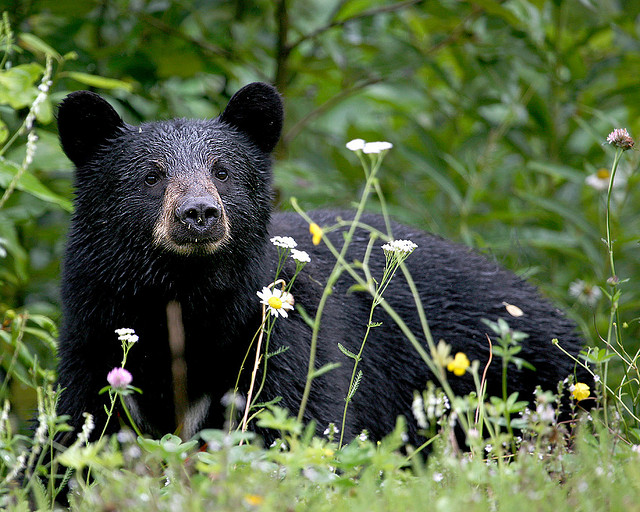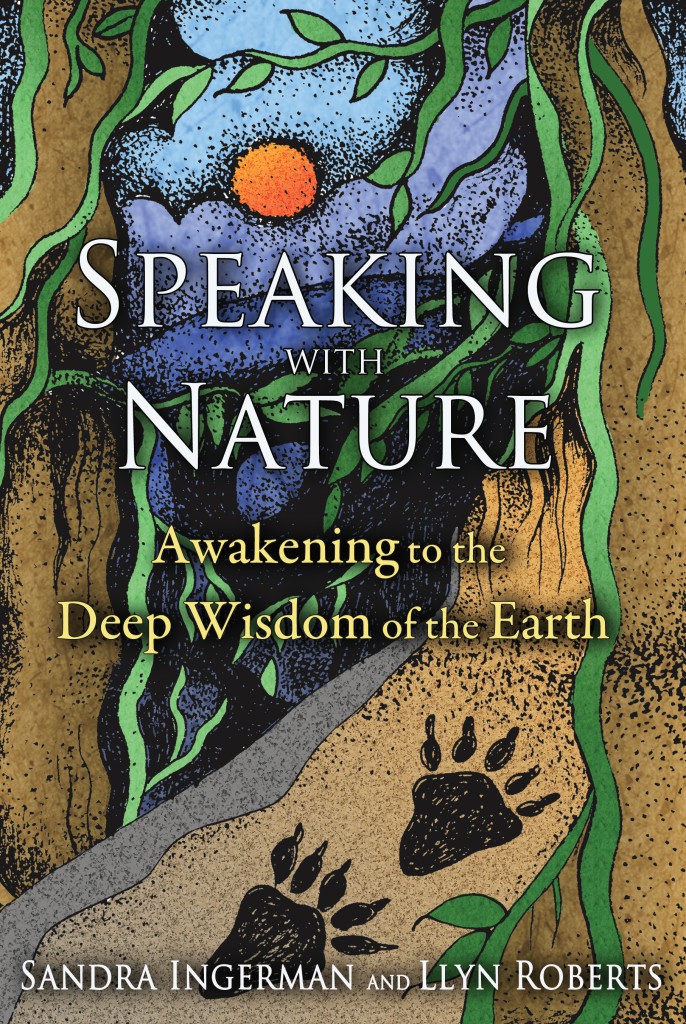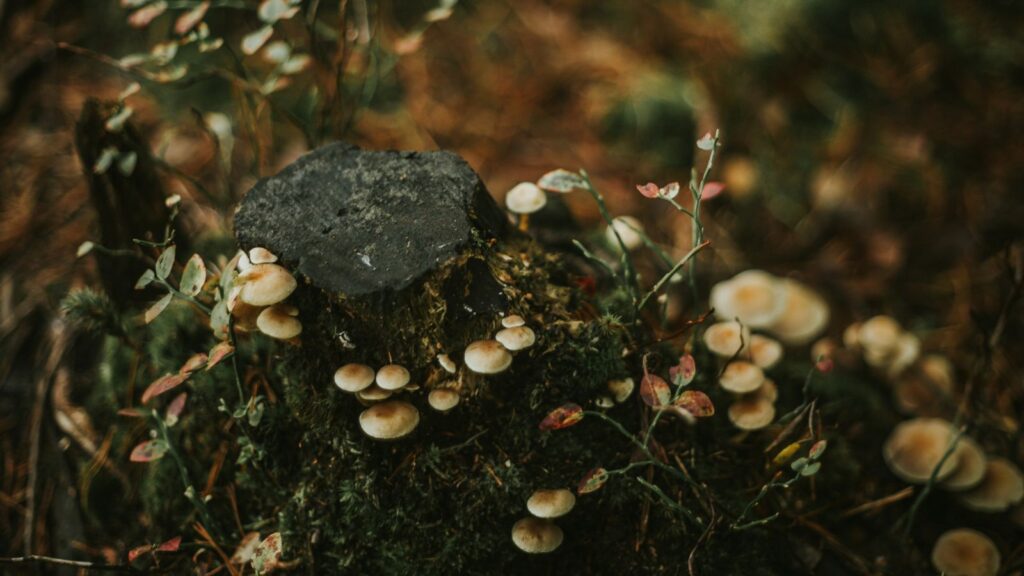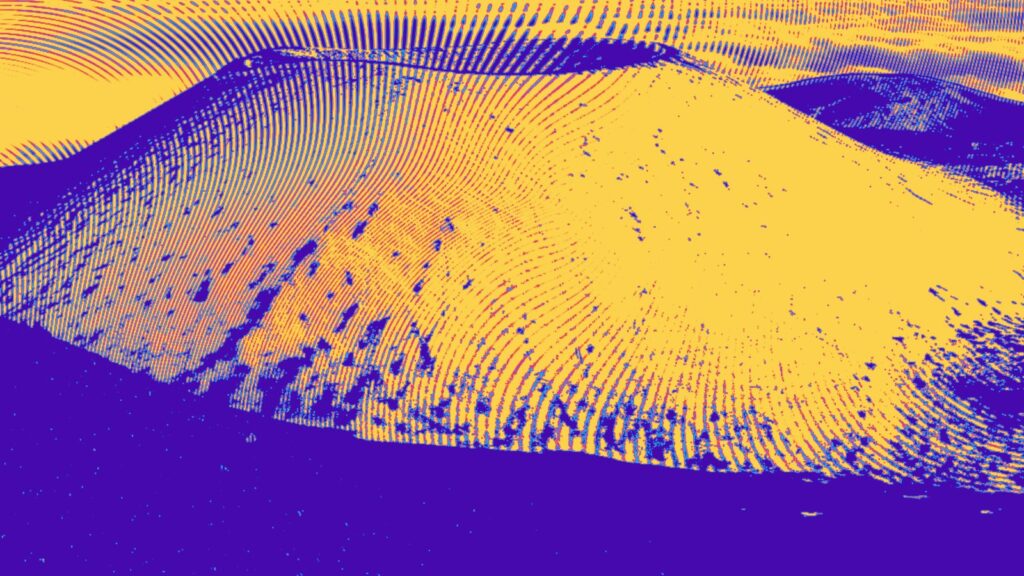The following article is excerpted from Speaking with Nature: Awakening to the Deep Wisdom of the Earth by Llyn Roberts and Sandra Ingerman, published by Bear & Company.
Black Bear
The densely forested lands where I live on the wild side of the Hoh River are known to be bear country. The nearest town is a forty-minute drive, assuming a fallen tree or swollen stream hasn’t blocked the road. Intending a quiet weekend in the wilderness, sometimes people become stranded here for a week. The Black Bears, however, fare just fine.
When I was driving into town recently, a Black Bear sprang out from the forest and bounded down the road ahead of my car. Imagine a two-hundred-pound animal running in front of you; how fast Black Bears move and how strong they are.
“Black Bear, why does your power enthrall us so?”
Anyone who’s encountered Bear in the wild will know.
Black Bear is reclusive and silent, with the exception of a mother with her cubs. If she senses a threat to her young, the nurturing female becomes a violent defender.
Earlier in my life, while living in New England, I occasionally chanced upon Bears. One time I was walking on a dirt road when a mother with two cubs ventured from the woods. Luckily for me, though I was standing within feet of the Black Bear family, they passed by and reentered the forest on the other side of the road.
Another time, upon hearing garbage-raiding raccoons, I ran out my front door to scare them away from the trash. No coons in sight I was suddenly eye to eye with a Black Bear. I ran one way and was grateful that the Black Bear ran the other.
Many of us know that awesome feeling in the presence of a large, wild creature of nature. If you have not experienced this, perhaps you’ve felt similarly as ocean waves crashed at your feet, during a powerful hailstorm, in close range to a lightning bolt, or at other times when nature’s potency was close.
In musing with Black Bear, the sacred feminine reveals, “This primal force is who you are.”
Old Norse warriors directed this natural, often dormant power by wearing bear-sarks (bearskin shirts rubbed in herbs and oils) to elicit fearlessness in battle; this may be the derivation of the word berserk. These men also likely ate—or painted their skin with—plants that evoked bearlike strength.
The solitary and gentle Black Bear mother, a supreme nurturer, is ferocious if she needs to be. And males may attack if food is scarce, for intensity is about protecting and surviving.
We may not wear bear-sarks, but people fight to stay alive and keep out influences they fear, just as a mother Bear does with her cubs.
Black Bear models an easy, uncensored flow of expression: from wild, intense, or forceful to tame and gentle, and back and forth. Healthy toddlers who play, cry, laugh, throw a temper tantrum, and then fall fast asleep are just as versatile.
Intense energy can invigorate and stimulate creativity. For instance, although I need calmness to write, I take frequent breaks outside. Taking a few barefoot steps in the snow or freezing river, getting drenched by rain, or running in a sharp wind inspires my writing.
Like a guileless child, the divine feminine sees everything as the one. Just so, every aspect of us, whether we judge good or bad, or agitated or peaceful, makes the whole of who we are. Just as agile Black Bear rolls around on the earth for the pure pleasure of it, that same type of playfulness and movement helps us stay authentic.
“Embrace all of who you are to touch your natural power,” says Black Bear. “Trust and relax. Play.”
It was hunting season when the Bear lunged in front of my car in the Olympic Mountains. In sobering contrast to that amazing surge of life that bounded down the road, my weekend neighbor shot a Black Bear a few days later.
Black Bears have few predators, and humans are among them. Black Bear hunting in these mountains traces back to honorable pursuits of the original Hoh tribe, whose descendants live nearby. Hunting practices have changed, however. Bear pelts yield a high price, and using guns instead of arrows distorts the balance between land, people, and animals. The old ones revered the land the Bears roamed and used the animal’s meat for food; fat for waterproofing; pelts for rugs and warm garments; teeth, claws, and bones for totem energy and jewelry; and so forth.
As hunting Black Bears in these forests is a fact of life, and one was shot while I was writing this chapter, I went over to see the freshly killed Bear stretched out in my neighbor’s truck bed.
Imagine burrowing your fingers into the thick pelt of a freshly killed Bear, its luxurious fall coat the blackest of blacks. I did this and stroked the Black Bear’s head and fingered its long, curled claws. I held a heavy Bear paw in my hand and touched its leathery footpad.
The hunter, my friend Monty, eyed me inquisitively.
“You’re sad for the Bear, aren’t you?”
I admitted my heart was heavy. Struggling for words, I stopped trying. The Black Bear had given its life and was soon to be skinned. I just wanted to admire it.
Imagine gliding your hand over the length of an almost six-foot-tall Black Bear’s furry leg. My fingers and palms still recall the Bear’s coarse hair and the firm muscle under its hide. I was grateful to appreciate the Black Bear soon after it died and to wish its spirit well.
Monty pressed on, “You feel bad for the Bear, don’t you?”
I smiled, touched by my friend’s sensitivity. Perhaps he, too, felt for the Bear he had killed.
As Monty and his son skinned the Black Bear, I discovered its inner physical landscape. Most striking were the intense smell and pure white fat packed between skin and muscle, although there was nothing about this nature being that didn’t amaze me.
I used to cringe at death and find such scenes appalling before I traveled to the Asian steppe with my friend and colleague Bill Pfeiffer and saw how indigenous Siberian people relate to the animals they kill. In the Shor Mountains years ago, Bill and I watched a community slay and dismember a cow. Every member helped, and every part of the animal was used. It was mid-November and fifteen degrees below zero when this occurred. Having ample stores of meat is essential in this part of the world where winter temperatures drop to sixty below zero, just as animals need ample food and fat to manage long winters.
Many Siberian shamans still practice animal sacrifice. Bill Pfeiffer and I saw some that were horrible and belabored. However, in the Republic of Tuva, the rams died swiftly. A small cut was made in the chest and the shaman reached in to choke the heart. There was ceremony and communication with the animal. The ram was honored and every part of it used, including the intestines. I watched the women adeptly flush these with water, fill them with blood, and tie the ends to make sausages. Though it’s difficult to watch the killing of a ram (rightfully so), nowhere else have I witnessed such beauty and honor in the taking of an animal’s life.
There was no bringing back the Bear on the skinning table in front of me. Although I eat little meat, I very consciously and gratefully ate the delicious rich stew that Monty made two days later. I should always be so aware. Having known the Bear that became this stew, and the hunter who related with the animal from beginning to end, the connection of food to its source was strong. This made the eating of it an entirely different experience.
That life lives on life, the “universal game,” as renowned mythologist Joseph Campbell described it, is visibly true in the wilderness. Dying and killing are part of the life cycle, although ironically, the powerful body of Black Bear grows mostly on plants and berries with just a little meat. This gives us much food for thought. In modern times of trophy hunting, commercially raised and slaughtered animals, and rapidly disappearing animal habitat, it would be wise for us to adopt the Hoh way of honoring life, to take on Bear’s fierce protectorship qualities to guard the health of our lands and natural ecosystems.
Our fascination with Bear spans centuries and has been diversely expressed. For instance, fairy tales are filled with Bears. Bear has inspired clans and cults all over the world for centuries, and we can still draw upon Bear power today.
Bear spends most of the winter in sleep, making it a natural ally for the dreamtime. The teddy bears our children dream with are a twentieth-century expression of this that continues to this day. Teddy bears got their name when President Theodore Roosevelt was scoffed at for refusing to shoot a trapped older bear.
Like hibernating bears, shamans dream and mystics incubate in caves, forests, and the desert—to heal, see the future, and seek counsel from spirits. The dream chamber is revered in indigenous cultures, and the dreamer’s solitude is fiercely protected.
Few of us will ever live in a cave or become a hermit in the forest, yet we all need to isolate sometimes as if in a dark cave to rest and restore. We also need to dream and touch deeply into the Earth.
Unlike ancient seers who mused as Bear does, belly to the earth, Black Bear is neither visionary nor healer. Nor does she distinguish goddess, guide, god, or deity or—as humans do—dissect life’s rhythms into time. For Bear there is only the sense, movement, and texture of now.
Resting in winter’s womb, Bear’s physiology slows as she attunes to Mother Earth’s heart. In also slowing, we can relax habits and ideas of who we are to muse humbly upon our Earth Mother’s heart.
In these powerfully shifting times, Black Bear guides us to a deeper way of knowing and being.
“The dreamer is the Earth. She is the wisdom whisperer,” says Bear.
As Black Bear releases into this dreaming Mother, so can we.
Practices
This practice is intended to revive the ancient art of incubating to restore, dream, and connect with the Earth. Enact this alone or have a friend protect the dream space for you; then do the same for your friend.
Whether inside or out, ensure you are safe, comfortable, and uninterrupted.
If inside, create a dark, cozy space perfect for a human bear to hibernate. You can dedicate such a spot in your home. Fiercely protect your time for solitude.
If outside, create a special place on the land and incubate when you travel. In closing our eyes, or upon simply taking a full, deep breath, we can touch the earth wherever we are, even in a busy setting.
Incubate directly on the earth when possible or on a natural fabric blanket so the earth’s energy flows unimpeded. Sense where you are called and ask permission to be here. Note the nature beings that surround you, who form a sacred circle to support your experience. Make an offering to them and to the spirit of the Earth: a prayer or song, some breadcrumbs or tobacco, or simply place your loving hands upon the earth.
If you are indoors, create a simple opening ritual such as drawing with your fingers an imaginary circle of light around you so the area where you rest will be held as sacred and offering to the spirit of the Earth a poem or a spontaneous prayer that comes from the heart.
Next, stretch, breathe, and invite Black Bear’s presence. Call upon her ageless body wisdom. As the silent Black Bear, stretch and unwind to find a quiet inner balance.
When you feel relaxed and fully present, sit down or lie curled on one side as if in a fetal position, with palms flush to your forehead, which opens the portal of your third eye vision. Or lie with your belly to the earth, or lie on your back. See what feels right.
Take some full, cleansing breaths, relaxing further with each exhale. The Earth can handle whatever emotion or energy releases with the outgoing breath. Unleash fully into the earth. Relax into the Mother’s loving embrace.
Now, whether you are indoors or outside, sense nature all around you. Sense the land extending to the far horizon. Imagine animals, trees, sand, and soil; also insects, birds, stones, minerals, and roots. Note mountains or flatlands, rivers, winds, and lakes. Most important, feel deeply into the earth through her many layers. Sense her heart.
As you travel in imagination, feel the Earth’s spirit—the radiant intelligence that flows through every nature being and you.
Words may not describe what you experience; words can get in the way. Relax. Feel. Breathe with the Earth. Breathe out love and breathe in love. Harmonize with this expanded field of energy; be it.
Take all the time you like.
Civilizations have come and gone, yet the Earth remains. Buildings, people, plans, and schemes all recycle back into the Mother. We are all one with this powerful intelligent force. Feel beyond the givens of our time—including time itself—deeply into this Mother.
When this feeling is strong, stay with the sensations. The Earth is you. Feel who you are. You may relax so much that you fall asleep, as you deeply integrate Earth rhythms.
Take all the time you desire.
To transition, freely stretch, as Black Bear does when rousing from slumber. Stay with the feeling, the Earth force that is you, throughout your day.
You can journal on visions or insights. Most importantly, feel the Earth—in your waking moments and even as you drift to sleep.
As Black Bear is in intimate relationship with the large, contiguous tracts of land (now quickly disappearing) it roams, get to know your own lands and those to which you travel. Wander. Be curious. If you can’t walk the land, open your heart to feel it. Notice what occurs as you do. Through intimacy with the land, you may be called to activate Black Bear’s fierce protector qualities to safeguard it.
When fragmented, fearful, and at any time, feel the Earth and sense her spirit. Harmonize with her until you feel a deep sense of belonging. In turn, give back to this Mother all that you can. Life will change. The Mother will manifest her dreams through you.
Black Bear teaches oneness with our sentient planet. She reminds us to honor death as much as life and that polarity is part of a larger whole. Here’s a practice to rouse your Bear power and explore opposing qualities.
Ponder some of your contrasting personality traits, or parts of you that you find pleasing (smart, happy, beautiful) and the aspects you may not like (shy, temper-prone, undisciplined). Call upon Black Bear for help and remember that all aspects of you are welcomed.
Similarly, you can bring to mind a seemingly either-or situation, such as:
“Do I quit my job or stick with it?” or “Do I dig deeper into this relationship or move on?”
Look at divergent traits or choices, then settle on a set and focus your attention.
In a space where you won’t be disturbed, stand, relax, and take some full, deep breaths. Call in Black Bear; invite her body to meld with yours. Take all the time you like.
Now, hold your bear paws in front of you at shoulder height, palms facing forward yet with hands close to your chest.
Choose a paw for each opposing quality, for example: “Left paw for my quiet side and right paw for my wildness,” or “Left paw for staying at my job and right paw for leaving.”
Gently and slowly move your left paw forward from your chest, and then take your time to move it back again. Next, keep this paw close to your chest as you gently and very slowly push your right paw forward. Then gently and slowly bring it back. Let your breath flow with your movement.
Move unhurriedly, alternating each paw back and forth several times. Let the feelings connected to each choice or quality come up as you move in this leisurely manner.
Listen to your body. Note what you feel as you slowly move.
When the time feels right, as if you were a Bear rolling in the sun, play with these tensions. Engage your body. Step, move, or even dance as you press left paw forward, then back. Then repeat with the right paw. Let the movement rise from within you. Begin slowly, then find your pace.
After some time consider moving one paw forward, and the other back, simultaneously.
Be fluid, keeping a good footing on the earth (Bear footprints resemble human footprints). Allow the mystery to move you.
Bear prods: “Try replacing the word ‘or’ with ‘and.’” Rouse energy and see what joins in the play.
Black Bear says, “Dance with me. Things are not separate; every moment is fresh. Charge your primal force; ask your body to show you how to integrate all the parts that make up you.”
Dance with Bear all you like, until you lose interest. Then take a gentle stroll. Step with gratitude, thanking Black Bear and releasing her with every movement.
As you walk, note how you feel in body, heart, and mind.
Also note how you feel now about the issues you explored. Is this different from when you began? If so, how?
You may later want to take some notes or reflect more on how to invite Black Bear’s wisdom into your everyday life.
Teaser image by Jitze Couperus, courtesy of Creative Commons license.
















